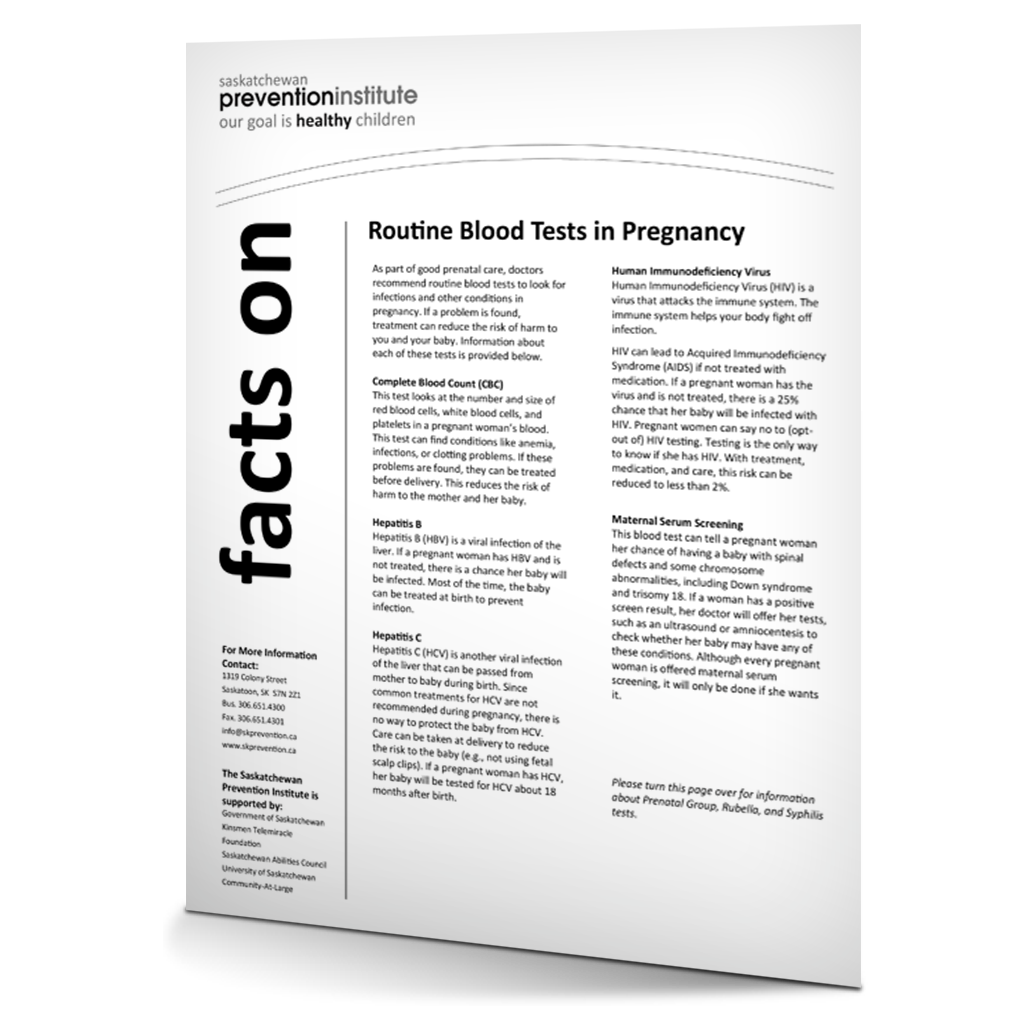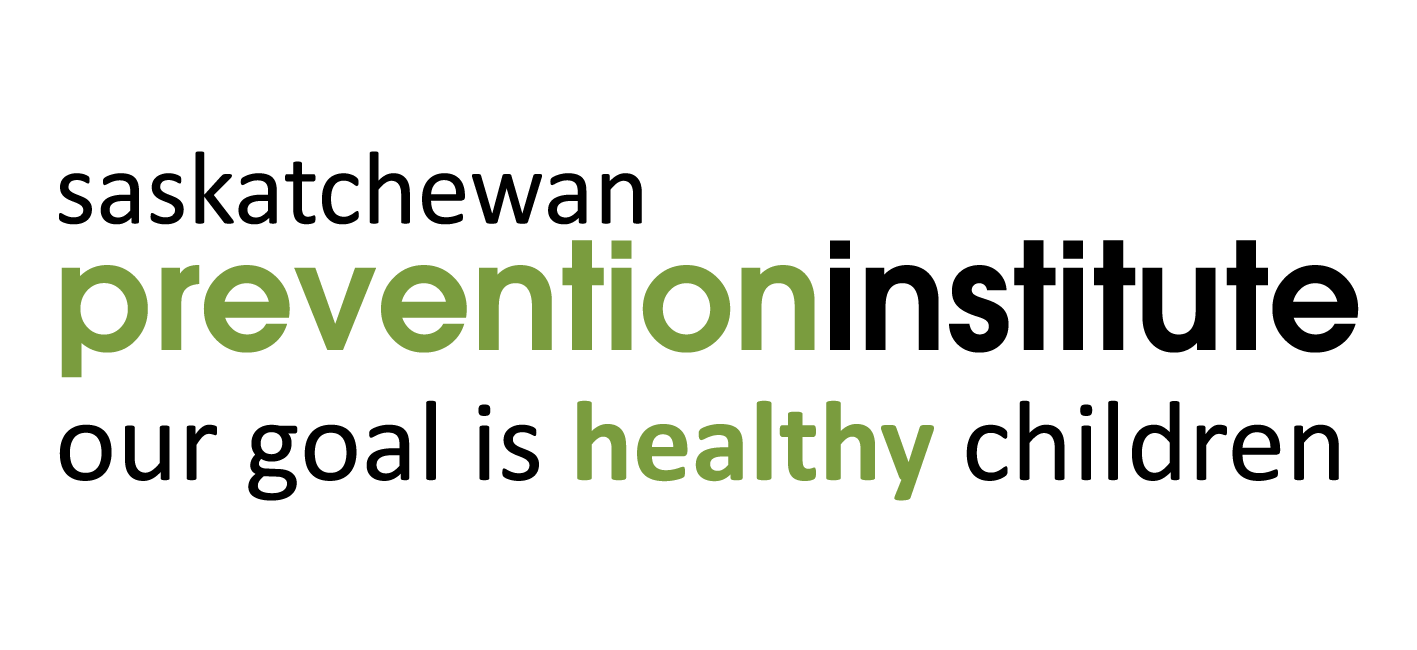
- Display 15 Products per page
-

Screening for HIV as Part of Prenatal Care Prior to Week 36
Poster, 2016
This algorithm provides Saskatchewan-specific guidelines for HIV screening in pregnant women prior to 36 weeks gestation.
SKU: 7-009 -

Postpartum Depression and Mental Health Concerns: The Impact on Young Children
Fact Sheet, 2010
Approximately 10% of mothers experience postpartum depression. Postpartum depression and mental health concerns impact every aspect of a person’s life, including body, mind, and spirit; extended family and friends; partner and baby. This fact sheet not only discusses the impact that maternal mental health can have on young children, but also ways in which professionals can support families when this is a concern.
SKU: 8-101 -

Late Preterm Infant (Near-Term)
Fact Sheet, 2023
A late preterm infant is a baby that is born between 34-36 (almost 37) weeks of pregnancy. This fact sheet provides information about some health problems that might affect a late preterm infant, things that caregivers and parents should watch for, and some questions to be discussed before leaving the hospital.
SKU: 2-201 -

Vertical (Mother-to-child) Transmission of HIV: Prevention, Treatment, and Education
Report, 2014
Saskatchewan continues to see high rates of new cases of human immunodeficiency virus (HIV) infection in comparison to the rest of Canada. A large number of these new cases are being identified in women of childbearing age.
Recognizing the importance of understanding HIV in the context of pregnancy, the Saskatchewan Prevention Institute conducted a review of the literature in this area. The review includes findings and recommendations on vertical transmission, transmission prevention, barriers to prevention, and health promotion around these topics.
Download the Vertical Transmission Executive SummarySKU: 7-501 -

Gestational Diabetes Fact Sheet
Fact Sheet, 2020
Gestational diabetes, also known as gestational diabetes mellitus (GDM), is a sub-type of diabetes that is first identified during pregnancy. This fact sheet provides information on risk factors for developing GDM, its impact on maternal and child health, screening and diagnosis, as well as recommended management and primary prevention strategies.
SKU: 2-442 -

Routine Blood Tests in Pregnancy
Fact Sheet, 2013
As part of prenatal care, routine blood tests are recommended for all women. If these tests identify an infection or another condition, treatment can reduce the risk of harm to the pregnant woman and her baby. This fact sheet provides information on routine blood tests conducted. The sheet comes in pads of 50.
SKU: 2-427 -

GPC Evidence Summary
Report, 2016
Group prenatal care is a model of group where eight to twelve women of similar gestational age meet as a group with their healthcare provider for 90-120 minutes of regularly scheduled appointments, starting in their second trimester and continuing throughout their pregnancy. During these appointments, each woman has a brief individual physical assessment with the healthcare provider and then participates in a group discussion led by a healthcare provider. All prenatal care is provided in this group setting, combining the usual physical assessment with peer support and increased time for education about healthy pregnancy. This report examines current research on group prenatal care to assess if it is a good model of care for Saskatchewan and if there is an improvement in birth outcomes and breastfeeding rates associated with using this model of care compared to individual prenatal care. Birth outcomes examined in this report are gestational age at birth, preterm birth, and low birth weight.
SKU: 2-904 -

How Your Baby Grows
Booklet, 2002
Adapted with permission from March of Dimes, this illustrated booklet describes fetal development and physical changes experienced by the mother.
SKU: 2-100 -

Gestational Diabetes Risks Prevention and Treatments
Literature Review, 2020
Gestational diabetes, also known as gestational diabetes mellitus (GDM), is a sub-type of diabetes that is first identified during pregnancy. It consists of abnormal glucose tolerance or higher than normal blood glucose levels, that may or may not diminish following the birth of an infant. Over the past decades, GDM rates have continued to increase in Canada. This review provides information on the risk factors for developing GDM, its impact on maternal and offspring health, the approach to screening and diagnosis, recommended management strategies (both pharmacological and non-pharmacological), as well as primary prevention strategies.
SKU: 2-448 -

Should I get the COVID-19 Vaccine if I am Pregnant or Breastfeeding?
Fact Sheet, 2021
This fact sheet provides evidence-based information on COVID-19 illness and vaccination in pregnant and breastfeeding people to help them make informed decisions about getting vaccinated.
A list of associated references can be accessed at: COVID-19 Vaccine in Pregnancy and Breastfeeding References.
SKU: 2-313 -

Substance Use, Pregnancy, and HIV/AIDS: Treatment Programs for Pregnant Women
Report, 2012
This living document identifies existing substance use treatment programs and services available to pregnant women and pregnant women living with HIV/AIDS in North America, with a particular focus on Saskatchewan. The information provided through the current environmental scan is useful both for pregnant women who use substances who are seeking services, and for healthcare professionals, who can use this information to assist women in accessing services that are appropriate to their needs. Ideally, this would be done as part of a multidisciplinary team, where the referring professional continues to be involved in the care of the woman. It is hoped that the information provided will increase awareness of the existing substance use treatment centres and programs for pregnant women, with the goal of potentially increasing referrals to and use of these programs.
SKU: 7-509 -

Prenatal eHealth Tools Report
Report, 2016
Expectant parents today have access to a wealth of information on pregnancy and childbirth, and much of that information is accessed electronically. Knowledgeable healthcare providers who understand the strengths and limitations of these new technologies are in an excellent position to offer expert guidance to women using these technology-based prenatal health tools. This report seeks to educate interested stakeholders about eHealth, what it entails, the potential benefits and challenges, and recommended options for using eHealth to provide quality prenatal information to residents of Saskatchewan.
SKU: 2-901 -

Edinburgh Postpartum Depression Scale (EPDS) Screening and Care Guide
Guide and Manual, 2012
The EPDS Screening and Care Guide provides healthcare providers with score interpretation and care guide to use when screening pregnant and postpartum women for depression and anxiety using the Edinburgh Postpartum Depression Scale (EPDS). It also includes guidelines for medical management when maternal mental health is of concern, contact information for Saskatchewan Healthline and Saskatchewan Drug Information Services, and a space for relevant local contact information. On the reverse side of the form there is a brief description of maternal depression including common symptoms, guidelines for screening, and the EPDS questions.
* For an updated version of the Maternal Mental Health Edinburgh Postnatal Depression Scale (EPDS) Screening and Care Guide available through the Saskatchewan Ministry of Health, please visit https://www.ehealthsask.ca/services/resources/Resources/EPDS-screening-2019.pdfSKU: 2-104 -

HCV and Pregnancy Fact Sheet
Fact Sheet, 2020
This fact sheet provides information about hepatitis C (HCV) and pregnancy, including information about vertical transmission (from mother to baby) and the effects of HCV on pregnancy and infants.
SKU: 7-500 -

Maternal/Perinatal Mental Health
Fact Sheet, 2023
This information sheet provides descriptions of organizations and how to contact them if a pregnant person needs assistance with their mental health before, during, and/or after pregnancy.
SKU: 2-808
